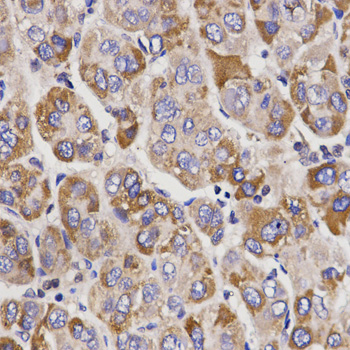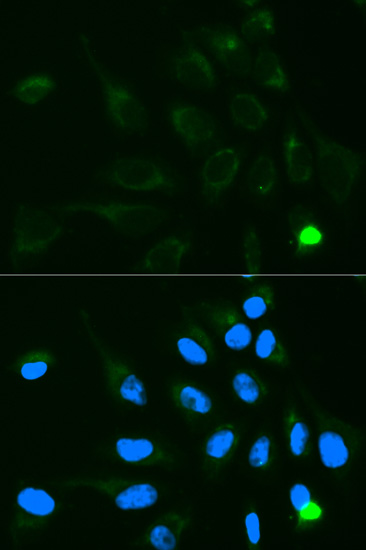Cell Biology Antibodies 7
Anti-UGT1A9 Antibody (CAB1661)
- SKU:
- CAB1661
- Product Type:
- Antibody
- Reactivity:
- Human
- Reactivity:
- Mouse
- Reactivity:
- Rat
- Host Species:
- Rabbit
- Isotype:
- IgG
- Antibody Type:
- Polyclonal Antibody
- Research Area:
- Cell Biology
Description
| Antibody Name: | Anti-UGT1A9 Antibody |
| Antibody SKU: | CAB1661 |
| Antibody Size: | 20uL, 50uL, 100uL |
| Application: | WB IHC IF |
| Reactivity: | Human, Mouse, Rat |
| Host Species: | Rabbit |
| Immunogen: | Recombinant fusion protein containing a sequence corresponding to amino acids 26-250 of human UGT1A9 (NP_066307.1). |
| Application: | WB IHC IF |
| Recommended Dilution: | WB 1:500 - 1:2000 IHC 1:50 - 1:200 IF 1:50 - 1:200 |
| Reactivity: | Human, Mouse, Rat |
| Positive Samples: | A-549, HT-29, MCF7, HeLa, Mouse liver |
| Immunogen: | Recombinant fusion protein containing a sequence corresponding to amino acids 26-250 of human UGT1A9 (NP_066307.1). |
| Purification Method: | Affinity purification |
| Storage Buffer: | Store at -20'C. Avoid freeze / thaw cycles. Buffer: PBS with 0.02% sodium azide, 50% glycerol, pH7.3. |
| Isotype: | IgG |
| Sequence: | GKLL VVPM DGSH WFTM RSVV EKLI LRGH EVVV VMPE VSWQ LGRS LNCT VKTY STSY TLED LDRE FKAF AHAQ WKAQ VRSI YSLL MGSY NDIF DLFF SNCR SLFK DKKL VEYL KESS FDAV FLDP FDNC GLIV AKYF SLPS VVFA RGIL CHYL EEGA QCPA PLSY VPRI LLGF SDAM TFKE RVRN HIMH LEEH LLCH RFFK NALE IASE ILQT PVTE YDLY SHTS I |
| Gene ID: | 54600 |
| Uniprot: | O60656 |
| Cellular Location: | Endoplasmic reticulum membrane, Microsome, Single-pass membrane protein |
| Calculated MW: | 49kDa/59kDa |
| Observed MW: | 71kDa |
| Synonyms: | UGT1A9, HLUGP4, LUGP4, UDPGT, UDPGT 1-9, UGT-1I, UGT1-09, UGT1-9, UGT1.9, UGT1A9S, UGT1AI, UGT1I, UDPGT1-9 |
| Background: | This gene encodes a UDP-glucuronosyltransferase, an enzyme of the glucuronidation pathway that transforms small lipophilic molecules, such as steroids, bilirubin, hormones, and drugs, into water-soluble, excretable metabolites. This gene is part of a complex locus that encodes several UDP-glucuronosyltransferases. The locus includes thirteen unique alternate first exons followed by four common exons. Four of the alternate first exons are considered pseudogenes. Each of the remaining nine 5' exons may be spliced to the four common exons, resulting in nine proteins with different N-termini and identical C-termini. Each first exon encodes the substrate binding site, and is regulated by its own promoter. The enzyme encoded by this gene is active on phenols. |
| UniProt Protein Function: | UGT1A9: UDPGT is of major importance in the conjugation and subsequent elimination of potentially toxic xenobiotics and endogenous compounds. This isoform has specificity for phenols. Belongs to the UDP-glycosyltransferase family. 1 isoforms of the human protein are produced by alternative splicing. |
| UniProt Protein Details: | Protein type:Endoplasmic reticulum; Transferase; Xenobiotic Metabolism - metabolism by cytochrome P450; Xenobiotic Metabolism - drug metabolism - cytochrome P450; Cofactor and Vitamin Metabolism - porphyrin and chlorophyll; Carbohydrate Metabolism - starch and sucrose; Lipid Metabolism - androgen and estrogen; Xenobiotic Metabolism - drug metabolism - other enzymes; EC 2.4.1.17; Carbohydrate Metabolism - pentose and glucuronate interconversions; Membrane protein, integral; Carbohydrate Metabolism - ascorbate and aldarate; Cofactor and Vitamin Metabolism - retinol Chromosomal Location of Human Ortholog: 2q37 Cellular Component: endoplasmic reticulum membrane; endoplasmic reticulum; integral to membrane Molecular Function:enzyme inhibitor activity; protein homodimerization activity; enzyme binding; retinoic acid binding; protein heterodimerization activity; glucuronosyltransferase activity Biological Process: negative regulation of transferase activity; flavonoid biosynthetic process; metabolic process; xenobiotic metabolic process; flavone metabolic process; retinoic acid metabolic process; cellular lipid metabolic process; negative regulation of fatty acid metabolic process; drug metabolic process; cellular response to hormone stimulus |
| NCBI Summary: | This gene encodes a UDP-glucuronosyltransferase, an enzyme of the glucuronidation pathway that transforms small lipophilic molecules, such as steroids, bilirubin, hormones, and drugs, into water-soluble, excretable metabolites. This gene is part of a complex locus that encodes several UDP-glucuronosyltransferases. The locus includes thirteen unique alternate first exons followed by four common exons. Four of the alternate first exons are considered pseudogenes. Each of the remaining nine 5' exons may be spliced to the four common exons, resulting in nine proteins with different N-termini and identical C-termini. Each first exon encodes the substrate binding site, and is regulated by its own promoter. The enzyme encoded by this gene is active on phenols. [provided by RefSeq, Jul 2008] |
| UniProt Code: | O60656 |
| NCBI GenInfo Identifier: | 29839451 |
| NCBI Gene ID: | 54600 |
| NCBI Accession: | O60656.1 |
| UniProt Related Accession: | O60656 |
| Molecular Weight: | 71kDa |
| NCBI Full Name: | UDP-glucuronosyltransferase 1-9 |
| NCBI Synonym Full Names: | UDP glucuronosyltransferase family 1 member A9 |
| NCBI Official Symbol: | UGT1A9 |
| NCBI Official Synonym Symbols: | LUGP4; UDPGT; UGT1I; HLUGP4; UGT-1I; UGT1-9; UGT1.9; UGT1AI; UGT1-09; UGT1A9S; UDPGT 1-9 |
| NCBI Protein Information: | UDP-glucuronosyltransferase 1-9 |
| UniProt Protein Name: | UDP-glucuronosyltransferase 1-9 |
| UniProt Synonym Protein Names: | UDP-glucuronosyltransferase 1-I; UGT-1I; UGT1I; UDP-glucuronosyltransferase 1A9; lugP4 |
| Protein Family: | UDP-glucuronosyltransferase |
| UniProt Gene Name: | UGT1A9 |
| UniProt Entry Name: | UD19_HUMAN |









